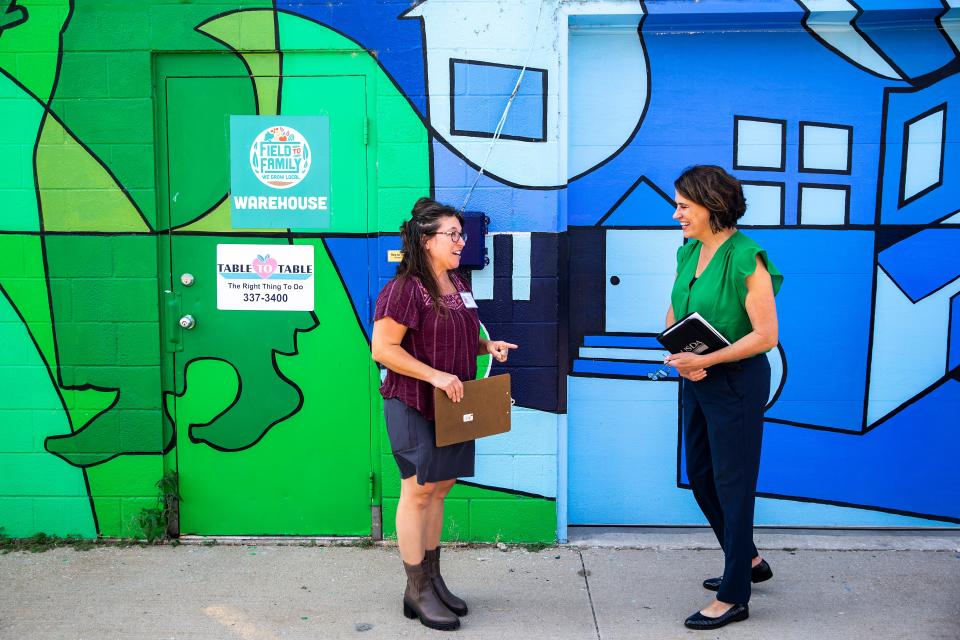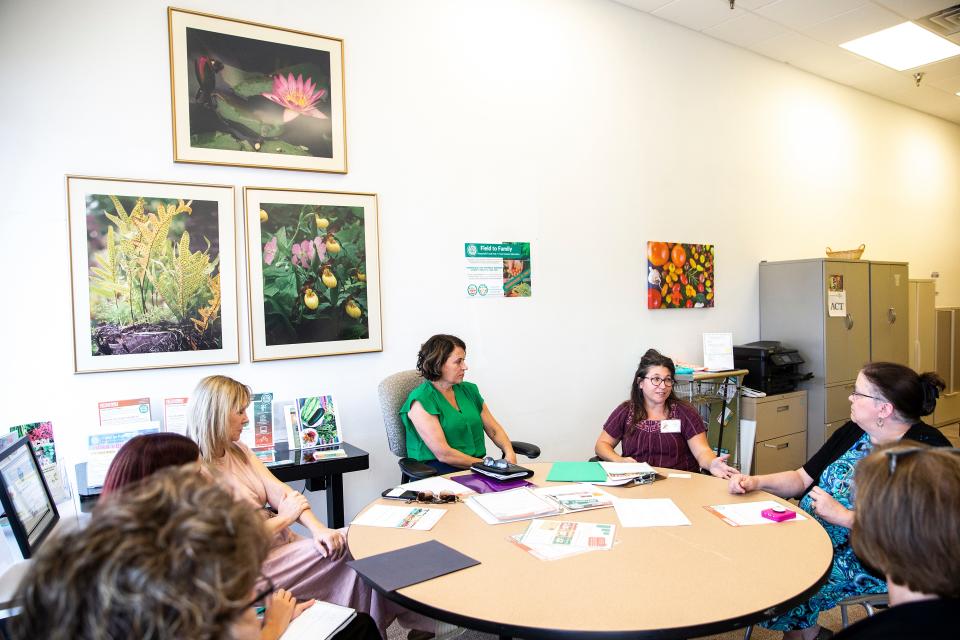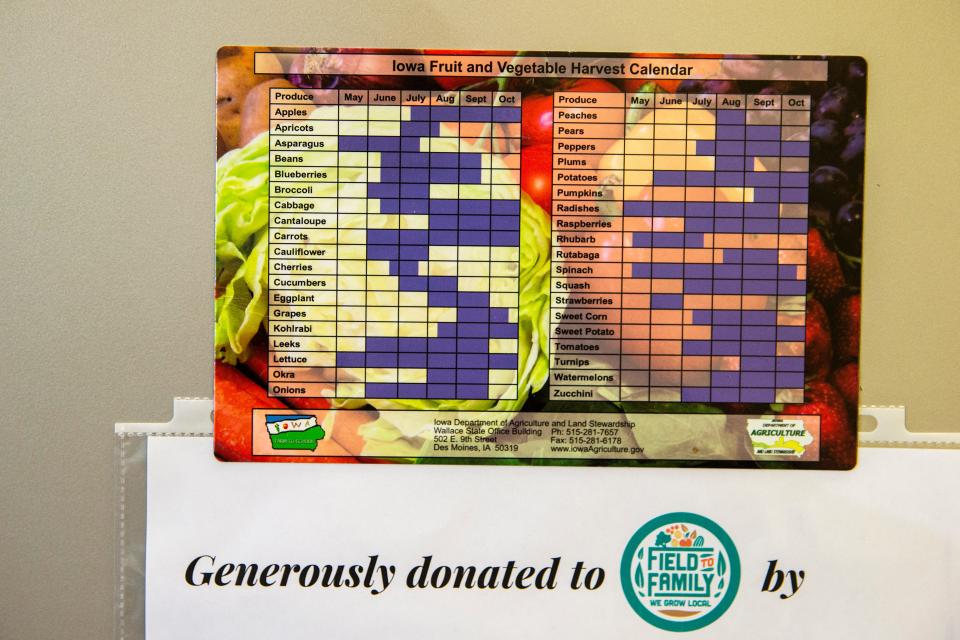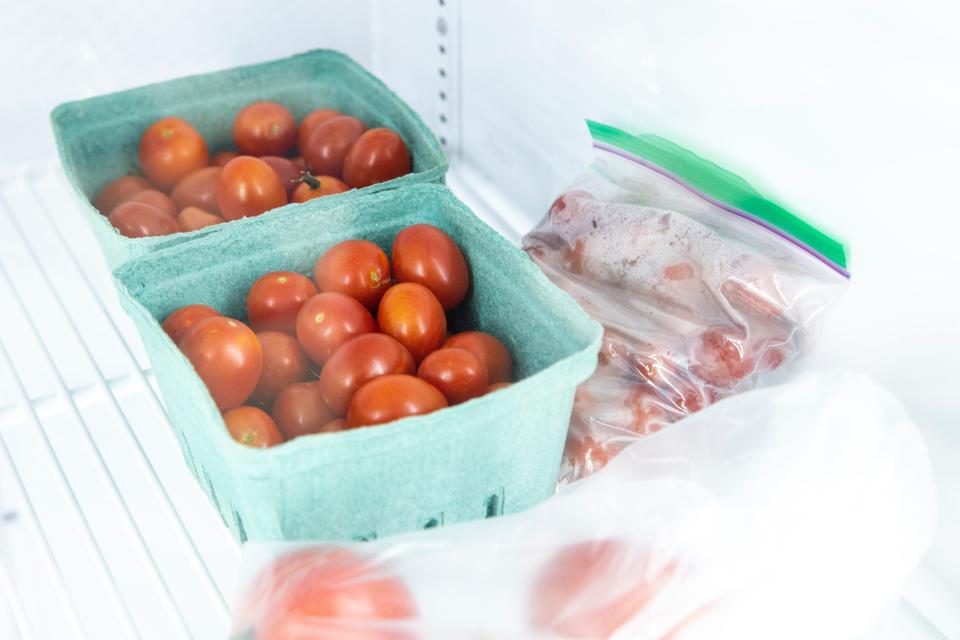Iowa City nonprofit Field to Family receives $200,000 grant to expand services for more local food
In the back of Field to Family’s shared building at the Pepperwood Plaza in Iowa City on a Thursday afternoon, three people meticulously filled rows of large brown paper bags with local food, from tomatoes to coffee and cinnamon rolls.
They were filling orders from people who used the Iowa City nonprofit’s online farmers market, which has worked with 32 vendors this year to provide an array of food for folks to choose from and receive on a weekly basis.
That’s not all the nonprofit does.
It provides local food for wholesale, such as for school districts or food banks, and provides educational programming about local foods to schools. The latter makes the nonprofit unique when compared to other food hubs, according to Michelle Kenyon, director of Field to Family.
It’s all for the purpose of creating a “more local, healthy and sustainable food system,” according to the nonprofit.
To get there means to continue increasing people’s access to local foods, which in turn means continuing to connect and foster relationships with the people that grow the food.
Thanks to a $200,000 USDA Healthy Food Financing Initiative grant in June, the nonprofit will get to expand its operations to ensure people are eating quality, local food.
“Every order (at Field to Family) is amazing,” Kenyon said. “It’s off the rails. It’s not on a traditional food system at all, so we’re really excited.”

What this $200,000 grant will mean for Field to Family and Iowa City
Field to Family launched as a food hub in Iowa City in 2018. A food hub, according to the USDA, is a centrally located facility that handles the aggregation, storage, processing, distribution and/or marketing of local, regionally produced food.
Processing isn’t something Field to Family does yet due to a lack of space, but it’s certainly the future, Kenyon said.
There’s a reason for that.
Processing food — washing it, cutting it up, transforming it for later usage — provides convenience. And convenience will be key to connect more people with more local food.
Field to Family will identify how its resources and services can be improved and adapted to better meet the community’s needs and then fund what is identified through this USDA grant.
Until research and engagement begins, Kenyon could only speculate as to what people might bring up when discussing how to make healthy, local foods accessible.
Satellite locations for picking up food ordered from the online farmers market could be an example, or ensuring that the online ordering system can be translated into different languages.
“If you think about accessibility and all the different angles, there’s a lot of things that we could do better,” Kenyon said. “We only have so many resources, though, so we want to find out what will affect more people and put the resources there."

For-profit, large food distributors are working “on a different level,” Kenyon said, doing their own research to know what people want all the time.
“When we’re trying to change and transform that system — because they’re not trying to change it, they’re just trying to feed it. … In order to change it into one that’s more resilient, strong and accessible, we gotta find out where people are and what they’re thinking,” Kenyon said.
The nonprofit strives to source from local growers within a 100-mile radius of Johnson and Linn counties. When it can’t, it’ll partner with other food hubs to meet the needs. As a bonus, those food hubs can take Field to Family’s extras.
There are nine food hubs in Iowa, according to Iowa State University’s online Iowa Food Hub directory. But a 2015 study led by the Leopold Center for Sustainable Agriculture found 31 Iowa food hubs or “centers of food hub-related activity,” so that number may not be exact.
What is clear is that the USDA is putting more money into local food, Kenyon said.
In 2021, $4 million was made available through the Healthy Food Financing Initiative to support “access to healthy food in underserved areas.”
“USDA is committed to creating steady, stable food supply chains in rural communities,” said Theresa Greenfield, USDA rural development state director in a news release about Field to Family being awarded a $200,000 grant.
“The Biden-Harris Administration wants to ensure that everyone — regardless of where they live — has affordable access healthy food. This expansion of food options in our rural hometowns provides new market opportunities for farmers and creates jobs for Iowans.”
In 2021, the food hub moved to 1051 US-6 in Pepperwood Plaza in Iowa City from its previous location on South Capitol Street.
The new location, shared with nonprofit Table to Table, puts Field to Family in the heart of the South District’s new Self-Supported Municipal Improvement District, something Kenyon expressed excitement to be part of.
Field to Family seeks to increase access to its resources and services in its new neighborhood as part of the research it plans to do, according to a presentation shared with the Press-Citizen.

With Field to Family’s assistance, two Johnson County school districts feed thousands
On the same Thursday afternoon at Field to Family, Debbie Klein, school food and nutrition director at Clear Creek-Amana School District, told Kenyon and other invited guests, including the Press-Citizen and Greenfield, how she once received a phone call from a parent regarding their child’s food habits.
During the COVID-19 pandemic, while students were at home and families were picking up school lunches curbside, one parent got to observe what their child was eating at school.
They had no idea their child liked cherry tomatoes, and was “eating them like candy,” Klein said.
These tomatoes were brought to students by local farmers through Field to Family and CCA’s partnership.
CCA is one of seven Iowa school districts Field to Family works with. The nonprofit also works with the Iowa City Community School District.
Alison Demory, director of nutrition services at ICCSD, said at the same Thursday meeting that working with Field to Family helps take the “sourcing burden away.”
At one point last year, ICCSD was serving 9,000 meals a day, according to Demory.
In an interview with the Press-Citizen, Demory said procurement specialist Cindy Smith works with the food hub to inform it of the school district's menu and how many servings are needed so that Field to Family can connect with farmers to get those orders fulfilled.
Field to Family provides signs in the cafeteria for students to learn more about the food they are receiving and where it’s from.
“Our participation with Field to Family and local foods has continued to grow every year, so what we don't get from local sources we get from our other prime vendor. We just like to get the local stuff whenever possible,” Demory said.
As the partnership has continued, Demory has found that farmers now know what to grow to meet the school’s meal needs.
Kids get served things like bell pepper slices, tomatoes, melons, sweet potatoes and more.
Whether it can be attributed to Field to Family, the Healthy, Hunger-Free Kids Act in 2010 that got more fruits and vegetables onto the plates of school lunches nationwide, or a combination of both, Demory has seen the evolution of students’ palates at ICCSD.
“I think there's no doubt that kids eat so many more fruits and vegetables than when we started (introducing these foods), and they are willing to try other things,” Demory said.

‘We should be eating Iowa food, grown by Iowans’: Why Field to Family is working to transform the food system
The expansion of Field to Family’s services means the nonprofit will need more food and, therefore, more people growing that food.
Food hubs sell products from 459 farmers in Iowa, according to a 2015 report on food hub development in the state from the Leopold Center for Sustainable Agriculture and other partners.
Farms that Field to Family worked with last year and in 2020 include Rainbow Roots Farm, Trowel and Error Farm, and Echollective Farm.
Kenyon said the demand in wholesale, local food is increasing. It takes up a “huge” amount of their workload, she said.
This year, the nonprofit has purchased from 20 growers for wholesale orders, according to Kenyon.
As a nonprofit, Field to Family doesn’t have to concern itself with making money. Instead, it thinks about trying to meet as many needs as possible, Kenyon said.
“Buy as much as you can from local farmers. They spend their time growing. We want them to spend time doing what they do well,” Kenyon said. “We will work with the customers to get them what they need.”
As Field to Family supports local farmers, it also seeks out relationships with what the USDA defines as “socially disadvantaged” farmers, or farmers who belong to groups who’ve been subjected to racial or ethnic prejudice. According to Kenyon, this also includes women, members of the LGBTQ community and more.
Field to Family is currently partnering with 34 market vendors who are considering “socially disadvantaged,” according to a presentation shared with the Press-Citizen. The grant will provide support to continue building these relationships and their demand.
The online farmers market allows Field to Family to be flexible with growers who are still determining how much they can grow and not have to meet the huge demands that other farmers have.
Field to Family has worked with farmers for so long that finding new growers, folks who have changed their business or retired, is always on the radar.
It also takes “conscious effort” and — perhaps unexpectedly — Facebook, to continue making those connections, Kenyon said.
The importance of all this work lies in food security.
“When it comes down to it, we cannot depend on food coming from far away as much as we used to. And in general, we shouldn’t be. We should be eating Iowa food, grown by Iowans, as much as possible. We have a lot to offer here in the state,” she said.
Paris Barraza covers entertainment, lifestyle and arts at the Iowa City Press-Citizen. Reach her at PBarraza@press-citizen.com or (319) 519-9731. Follow her on Twitter @ParisBarraza.
This article originally appeared on Iowa City Press-Citizen: Iowa City nonprofit Field to Family receives $200,000 USDA grant

